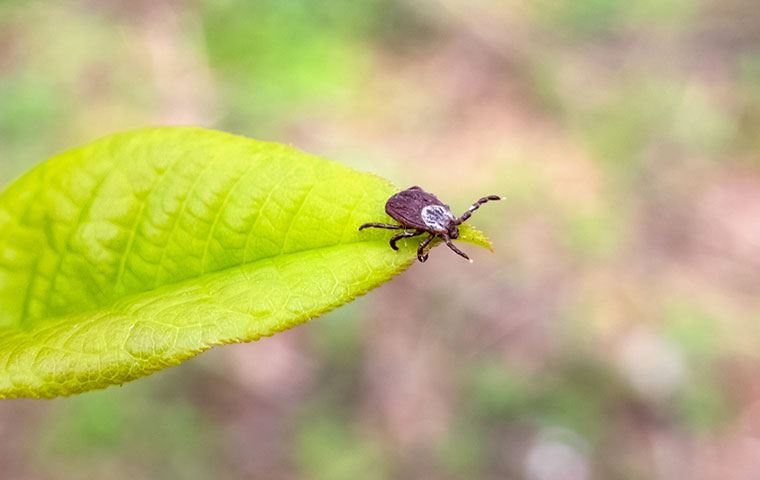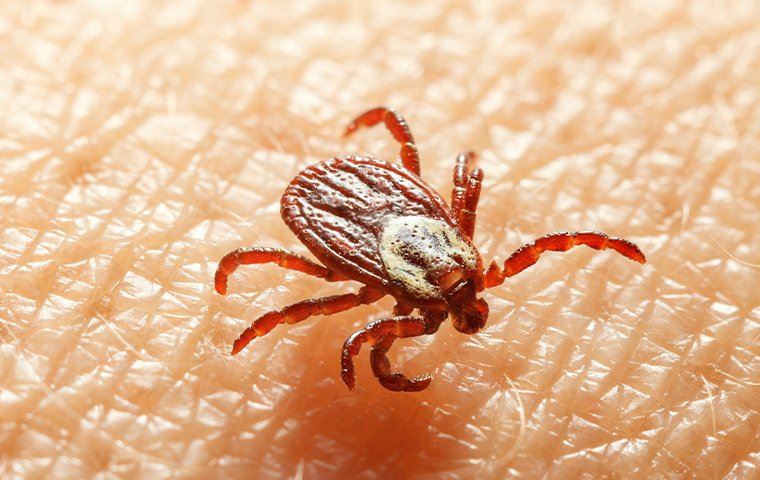
Tick Identification & Prevention
What You Need to Know About Ticks in Muskegon, MI

Ticks are common carriers of certain diseases such as Lyme Disease & Rocky Mountain spotted fever. Our pest control in Muskegon can help protect your West Michigan home and family.
Protect Your Pets from Ticks
If your pet spends time outdoors, tick checks should be part of your daily routine. Here’s how to spot a tick – and what to do if one has latched on to your pet.
Scan for ticks by running your fingers slowly over your dog’s entire body. If you feel a bump or swollen area, check to see if a tick has burrowed there by parting the fur and viewing the skin. Don’t limit your search to your dog’s torso: check between his toes, under his armpits, the insides of his ears, on the head, and around his face and chin. Ticks can be black, brown, or tan and they have eight legs. They can also be tiny: some species are only as large as the head of a pin. If you find a tick it needs to be removed. Follow the steps to removing a tick outlined below.

Why Choose Safeguard Pest Solutions?
-
Safe SolutionsYou shouldn’t have to worry that your pest control is more dangerous than the pests in your home. Safeguard Pest Solutions uses natural solutions to safeguard your home from all unwanted pests.
-
Quality ServicesAs a family-owned-and-operated West Michigan pest control company, Safeguard Pest Solutions provides safe, high-quality pest control services administered by licensed and certified service professionals.
-
Satisfaction GuaranteedAt Safeguard Pest Solutions, your satisfaction is important to us. We customize our safe treatments to tackle your pest problems, and our effective pest control guarantees your complete satisfaction.
Steps to Removing a Tick
- Grab The Tweezers - Use fine-tipped tweezers to grasp the tick as close to the skin’s surface as possible. Avoid pinching your skin.
- Pull Up - Pull upward with steady, even pressure. Don’t twist or jerk the tick; this can cause the mouth-parts to break off.
- Be Careful - If you are unable to remove the mouth easily with clean tweezers, leave it alone and let the skin heal.
- Disposal - Dispose of a live tick by submerging it in alcohol, placing it in a sealed bag/container, wrapping it tightly in tape. Never crush a tick with your fingers.
- Monitor the Area - If you develop a rash or fever within several weeks of removing a tick, see your doctor. Bring the tick you saved for testing.

Frequently Asked Questions About Ticks
Have questions? We are here to help. Still have questions or can't find the answer you need? Give us a call at 231-300-9558 today!
-
What are ticks?Ticks are related to spiders. They have eight legs, a flat, oval-shaped body, and are usually dark in color. Adult ticks are about the size of an apple seed. Ticks present a serious home pest control and commercial pest control issue because their numbers are on the rise, and if they attach to you or your pet they are hard to find. Ticks can’t fly, they don’t jump, and they won’t drop down on people or pets from trees. Ticks will latch on to your shoe or your pet’s paw and crawl up to find a place to attach themselves.

-
Where will I find ticks?Ticks are usually found in elevated wooded and grassy areas. Tall grass is a favorite spot for ticks to find their prey. Ticks eat blood to survive, so they live where the animals they feed off of roam. You can find ticks anywhere you find deer, birds, rabbits, squirrels, mice, and other rodents. Ticks detect a host using body odors, carbon dioxide, body heat, moisture, vibrations, and even by shadows. They like to make their home in places with lots of shrubs, weeds, tall grasses, and leaf litter. A single female, depending on the species, will lay a batch of eggs ranging from 1,000 to 18,000 eggs and then will die. The most serious problem with ticks is the diseases they can spread to humans, pets, and livestock.
-
Where do ticks hide on humans?Ticks are surprisingly fast and can move across your body quickly. You could find a tick nearly anywhere on your body. They prefer warm and moist areas. You will often find a tick in your armpits, groin, or scalp. While clothes do offer protection from ticks, they can still get under your clothes.
-
How can I protect myself from ticks?
- Use Insect Repellent
- Wear Light Colored Clothes
- Avoid Areas with High Grass
- Wear Long Pants
- Wear Long Sleeved Shirts
- Wear Socks

Happy Customers in Your Neighborhood
Proudly Serving West Michigan & the Surrounding Areas
Check out some of our recent reviews!
-
“Very good price compared to others. Jeff came sprayed where my bees were and they were all dead the next day. Excellent service!”- Shana Phelps
-
-
“Safeguard Pest Solutions of Muskegon MI is one of the best, customer friendly, fast response time businesses I have ever experienced. I called in the morning and Jeff was at my house that afternoon! He knew exactly how to handle my situation and immediatel”- Nan Johnson
-
“Always provides such good service! We’ve used for years and will continue to! Such good pest prevention!”- Emma Hichue
Safeguard Pest Solutions Blog
Want all the latest news or updates? Browse through our blog to read our most recent posts and featured articles.




